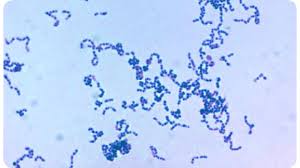Fannyhessea vaginae: Difference between revisions
| Line 23: | Line 23: | ||
Fannyhessea vaginae | |||
==Description and Significance== | ==Description and Significance== | ||
Revision as of 23:52, 27 November 2023
Classification
Bacteria; Actinimycetota; Actinomycetes ; Actinomycetales; Actinomycetaceae; Fannyhessea
Species
|
NCBI: [1] |
Fannyhessea vaginae
Description and Significance
Fannyhessea Vaginae (formerly atopobium vaginae) is a gram positive cocci shaped bacterium highly specific to Bacterial Vaginosis (BV) (Lu ́cia G. V. Sousa et al, 2021).
As an anaerobe (low to no oxygen) F. Vaginae creates polymicrobial biofilms that layer the vaginal epithelial cells providing the anaerobic conditions for optimal growth (Lu ́cia G. V. Sousa et al, 2021). The Biofilms produced by this microbe serves as a diagnostic marker for BV which is vital as most detection methods for BV fail.
Genome Structure
The F. Vaginae genome is a linear chromosome. The primary genome DSM 15829 is sequenced at 1.5 mbp, with one of the total 19 different strains only 461 bp. Most of the genes are protein coding, with 1200 genes coding over 18,000 proteins.
DSM 15829 contain a 5s, 16s, 23s rRNA; and a 30s protein s6. Encoded in this genome are sucrose metabolic pathways, glycan biosynthesis, and termination factor rho. In addition the NusB protein involved in RNA biosynthesis within eubacteria is regulated by modulating transcription and antitermination efficiency.
Cell Structure, Metabolism and Life Cycle
This organism uses utilizes carbohydrates through a glycolysis and pentose phosphorous pathway. Anaerobic glycolytic pathway breaks down glycerin-p down to pyruvate to be used in the production of energy. Pentose Phosphorous pathway breaks down fructose-6p that can end up In the input of the glycolytic pathway. In a further complex fashion during the break down via the glycerin-p, at the pyruvate stage this organism can switch its metabolism into a anabolic pathway to build the amino acid methionine from the serine intermediate.
Ecology and Pathogenesis
Habitat; symbiosis; biogeochemical significance; contributions to environment.
If relevant, how does this organism cause disease? Human, animal, plant hosts? Virulence factors, as well as patient symptoms.
References
Author
Page authored by John T., student of Prof. Bradley Tolar at UNC Wilmington.

